Krakow is an extraordinary city to visit on your own – especially if you’re interested in history and if you love good food. Here’s my personal list of places to visit in Krakow, as I saw them.
If you’re staying near Krakow’s main market square – and you should if you can – the first thing you’ll hear is the clip-clop of hooves on the smoothly worn cobblestones. The square is lined with elegant carriages, their costumed lady touts in full-color coordination with the horses’ coats, harnesses, and bridles, a festival of reds and blacks and whites.

You may hear a neigh or two but these horses are awfully well-behaved.
Of the many places to visit in Krakow, the market square is the city’s heartbeat – and your starting point.
But wait – there’s another sound: every hour on the hour, a trumpet player leans out of a window from the spire of St Mary’s Basilica. His short plaintive call once heralded the beginning and end of the day and informed Cracovians that the enemy had been kept at bay, that there were no fires burning anywhere, and that they could sleep safely.
A Krakow visit is not at all quiet. With its huge cohort of students and young people – about 60% of the 760,000 population – it’s no surprise the streets are filled with laughter and song. There is all manner of things to see in Krakow.
And it’s all friendly.
You cannot walk more than a minute in the old town without being accosted by a tout.
“Would you like to take a tour? No? No problem. Have a nice day!”
It’s hard not to fall in love with a city this polite, and entirely possible to explore without a Krakow city guide.
Yet nothing in Krakow’s history really prepared it for tourist fame. If anything, the city should be grim, or at least recovering from one of its many tragedies.
A bit about the history of Krakow
Where is Krakow?
The second-largest city in Poland, Krakow is found in the southern portion of this central European country.
Krakow’s history is as noisy as its streets, yet the city should have been well protected from harm. After all, didn’t Krakus, the city’s founding father, get rid of the Wawel Dragon who threatened its inhabitants?
A glorious dragon sculpture overlooks the city near Wawel Royal Castle, just by the banks of the Vistula River, reminding locals of a famous legend. According to the myth, a dragon wreaked havoc around the city, so King Krakus offered a reward for the hero who managed to slay it. Many knights fell to the beast until a humble shoemaker outwitted it with a trap: a sheep model filled with sulfur. The vile monster got so thirsty it fled to the river and drank and drank until its stomach burst.
Luckily, there’s still water left flowing in the Vistula – and you can take in the sights of the city on a cruise through the city on boat.
You’d think that event would have cemented Krakow’s good fortunes.
But no. Instead of a dragon-free destiny, the city was bounced violently from tribe to tribe, until finally, in the 990s, the Kingdom of Poland came into being, with Krakow its capital. Successive invasions prompted the building of ramparts and gates, of which the Florianska Gate is a proud reminder.
At last, the promised Golden Age materialized during the 14th century under Kazimierz the Great, who enlarged Wawel Castle (considered Poland’s spiritual heart), founded the city of Kazimierz (and encouraged Jews to settle there) and built what would become the Jagiellonian University, one of Europe’s oldest. He commissioned Renaissance buildings and his rule attracted luminaries from the arts and sciences, turning Krakow into an intellectual hub.
Sadly all good things end and Krakow was thrown a curve ball when the Polish capital was moved to Warsaw, igniting a semi-friendly rivalry that continues to this day between the two cities.
Krakow’s fortunes went downhill. More invasions, a Black Death epidemic that killed 20,000, and a series of partitions that stripped Poland of its sovereignty and placed it under the domination, at various times, of Russia, Prussia, and Austria.
Only at the end of World War I would Poland regain its independence – but that victory would be short-lived and tragedy would soon reappear, this time in the form of World War II.
To avoid destruction by the Nazis, Krakow’s mayor controversially proclaimed it an ‘open city’, undoubtedly saving it from destruction. When the Nazis marched in in 1939, rather than razing the city they set up their headquarters in Wawel Castle, the most revered of buildings. It was a slap in the face Poles still speak of with anger today.

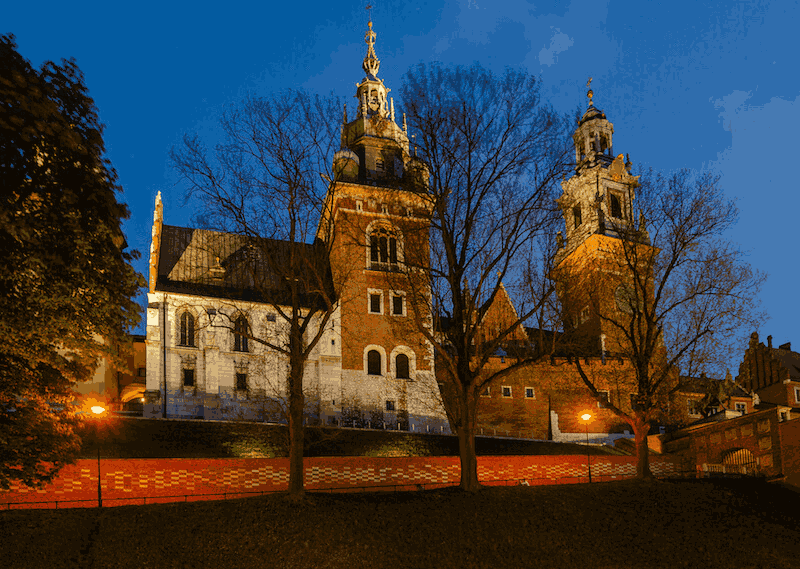
While parts of Poland were absorbed by Germany, Krakow became the capital of what would be known throughout the war as the General Government or Governorate. Even the country’s name was erased from history.
The Nazi rule of Krakow was harsh. The university’s professors were sent to concentration camps, and in the ghetto, Krakow Jews were marched to Auschwitz, history’s most horrific death camp, or shot on the streets. Only 10% of Krakow’s Jews would survive the war.
At armistice, just when Krakow thought it had tipped the odds, it was ‘liberated’ by the Red Army – and subjected to another four decades of tyranny, this time at the hands of the Soviet Union.
It would take the rise of Solidarity, the independent trade union, before Poland reclaimed its heritage and its name. Solidarity forced fair and free elections. Poland rejoined the world community, gave the Catholics a Pope, and became part of the European Union. Krakow has since attracted an ever-growing number of visitors and its entire old town declared a World Heritage Site by UNESCO. It’s now one of the most popular places to visit in Poland.
Poles, Nationalism and the Holocaust
Many people know some 2.4 million Jews died in Poland during World War II as a result of war crimes and atrocities. Far fewer are aware that a similar number of non-Jewish Poles died.* The Nazi occupiers planned to eliminate Poland’s leaders and intellectuals and Hitler ordered the “Germanization” of Poland.
A law approved in early 2018 seeks to reframe Poland’s relationship to the Holocaust by preventing the use of the term ‘Polish death camps’. The law, triggered by the ruling nationalist Law and Justice Party, claims that Poles were solely victims during World War II.
According to TIME Magazine, “Under the controversial Holocaust law, it is now considered a crime for anyone, apparently anywhere in the world, to accuse ‘the Polish Nation’ of complicity in crimes committed by the Nazis during World War II.”
However, as history has shown, most territories occupied by Nazi Germany were in some way forced to collaborate with the invaders, however grudgingly and little (or willingly and extensively). This in no way diminishes the heroism of those who resisted the Nazis.
* While many people dispute the exact figure, all agree it was extremely high, and that the number of Jews and non-Jewish Poles who were murdered was similar.
These Kraków attractions, experiences, and Krakow neighborhoods should be on your list
Krakow is many cities within a city, and places of interest in Krakow range from the somber and historical to the fun and whimsical. You can spend your Krakow vacations in the Old Town, in the Jewish quarters, or in the suburbs, or do as I did and meander or take the tram. It’s small enough to do that.
One of the best things to do in Krakow is to walk around and listen. You’ll hear things. The horses and bugle but also the clink of beer mugs, the ringing of the tram bells as you nearly step into their oncoming path, or music. In Krakow, you cannot escape the music.
Churches in Krakow seem made for evening concerts and your blood will chill when you hear a chamber orchestra perform Vivaldi and Mozart and Haydn against an ecclesiastical backdrop with perfect acoustics.

You don’t even have to go to church. Walk along any crowded street and the ethereal notes of a harp will float your way, or a violin, or a voice. With this many students, it isn’t hard to find one practicing her craft in the shadow of a nearby tree.
For a more formal setting, join one of the more popular Krakow tourist attractions when you settle in for an evening of Chopin at the Krakow Concert Hall. This hour-long concert is held every evening and it celebrates Frederic Chopin, one of Poland’s greatest composers (get your advance tickets here).
Of course, Krakow has many exquisite sights (or planes landing here wouldn’t be that crowded) so I’ll share a few Krakow places to visit with you but I won’t try to compete with any of the excellent guidebooks you’ll find on Amazon. No need for me to reinvent the wheel.
What to visit in Krakow – The Old Town
Life seems to begin and end around Krakow’s Old Town. You could spend days here and not wander beyond its confines. You’d see the Collegium Maius of Jagiellonian University, Krakow’s most famous and the alma mater of Pope John Paul II, and Nicolaus Copernicus, the mathematician, and astronomer who placed the Sun rather than the Earth at the center of the universe.
The pleasure of visiting this area is enhanced by the absence of cars (but beware cyclists and electric tourist carts – you won’t hear them coming). As you walk, you’ll inevitably reach Wawel Castle and be drawn uphill through its gates. The castle, in addition to its historical importance, is reputed to be built on a strong earth energy center… The castle is well worth a tour.
One of the most fascinating tourist attractions in Krakow is the market square Rynek Główny, the place to see and be seen. Sit on the steps, in any of the cafés, or have a drink above it all on the first floor of the Cloth Hall, at the Café Szal. Beware though – you’ll be tempted to take pictures but you’ll have to do it without a tripod, as they are not allowed. There’s a wide balustrade and you can always rest your camera on that. The blue hour is best if you want to capture Europe’s largest medieval square.
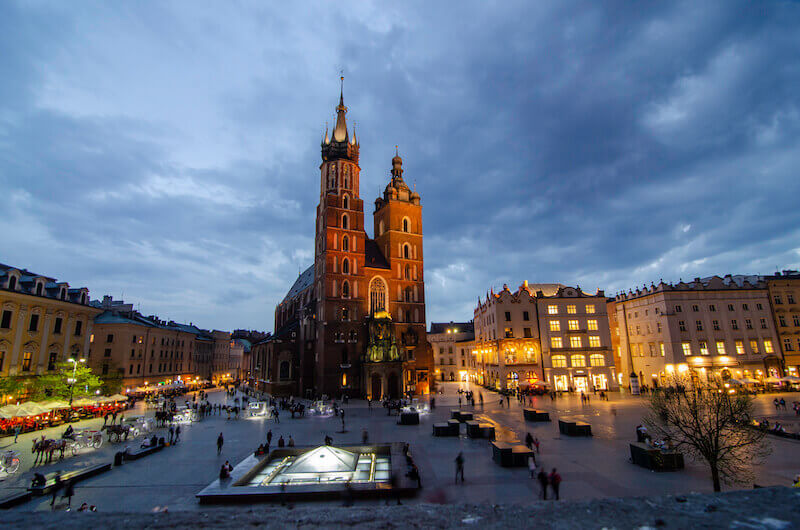


From your elevated vantage point, you’ll see three of my other best places to see in Krakow. First, the “Little Louvre” pyramid of the riveting Rynek Underground Museum, built on and into the city’s foundations (it gets crowded so I’d buy a ticket to skip the line).
Second, you’ll be facing Mariacki, St Mary’s Basilica, a bit ungainly on the outside but inside, dazzling and exquisite.
And finally, the building you’re on – the Cloth Hall – during the day houses a variety of souvenir stalls and shops. Back when I visited, shop #16 had tons of cookie-cutter items and the sales staff hovered over you like hawks – not a pleasant shopping experience. Shop #18, on the other hand, was (and hopefully still is) run by a friendly lady who stocks original items from a variety of artisans and artists.
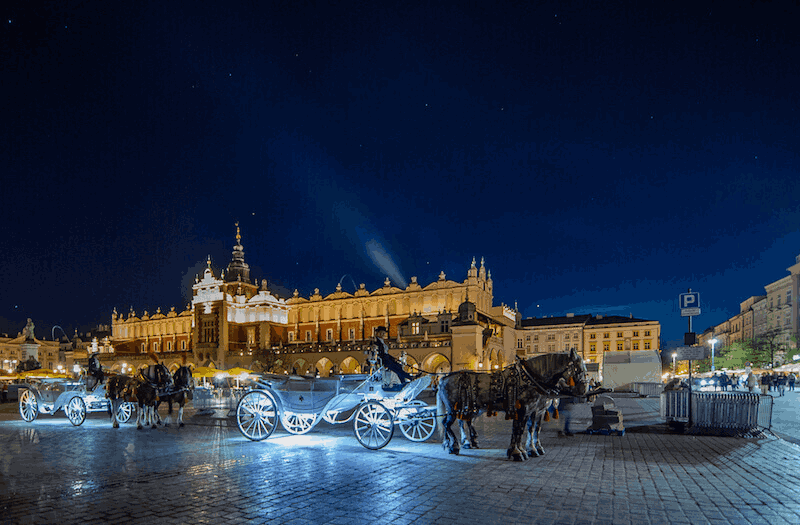
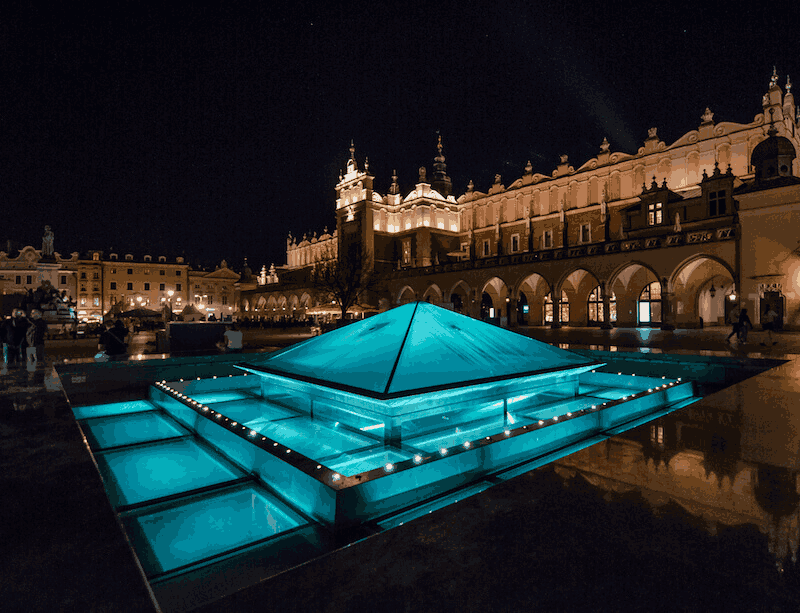
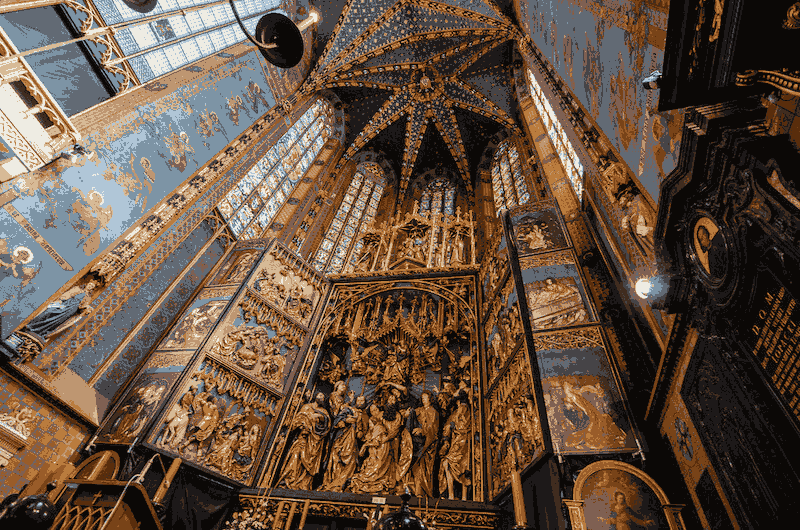
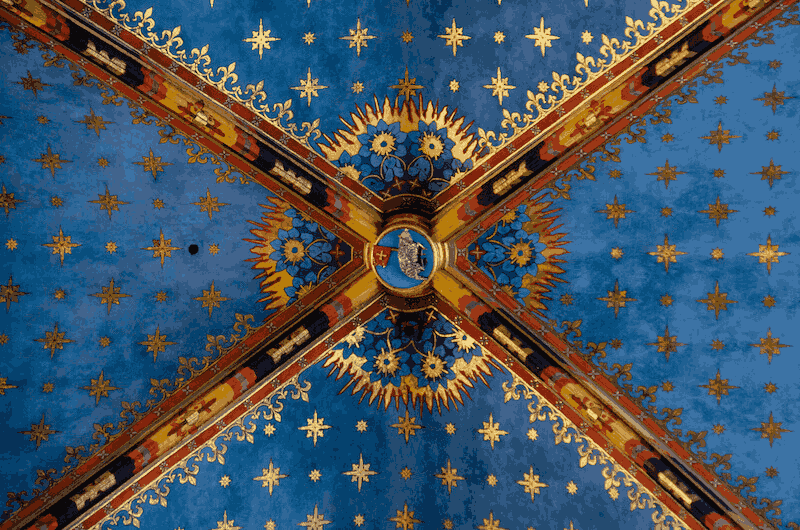
Or watch this brief video of Mariacki’s interior
What I didn’t do (but should have) was take a horse carriage ride during my tour of attractions in Krakow. I was intrigued by the sales dance: the brightly costumed women hail you as you go by, asking if you’d like a ride. If you say yes, once you negotiate the price a man hops on and takes the reins, with the woman sitting decoratively next to him. Hmmm. That said, it’s a lot less expensive than, say, a gondola ride in Venice and looks at least as fun.
World War II, the Jewish Quarter and the Post-War Era in Krakow
However fascinating and intriguing, at some point you’ll have to tear yourself away from the Old Town and your stop of choice must be Kazimierz, where Jews and Christians lived side by side for centuries. It has plenty of historical sights, along with the Jewish Galicia Museum and a collection of intriguing street art. Pop in and out of delightful art galleries and the city’s trendiest (and tastiest) restaurants, cafés, and bars.
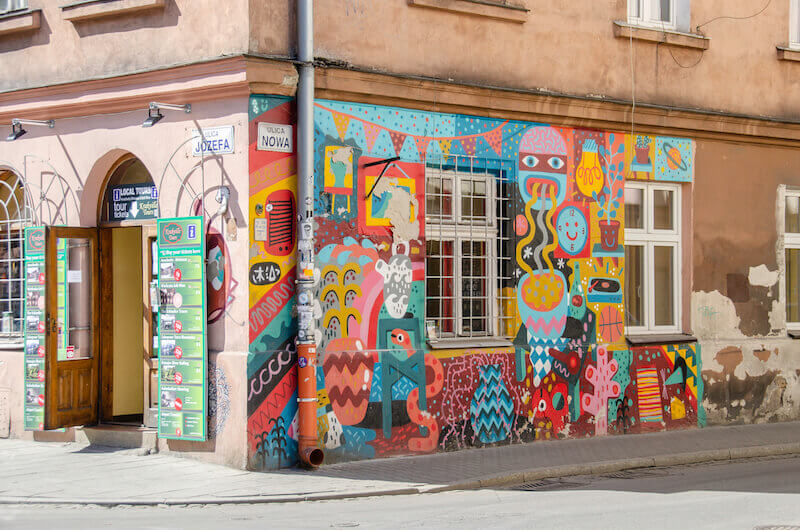
Those of you who have seen Schindler’s List, the Steven Spielberg film (or read Schindler’s Ark, the book on which the movie was based), know the story of Oskar Schindler, a controversial character whose unusual career took him from German spy to Nazi party member to industrialist in Krakow, where he helped save more than 1000 of his Jewish workers from certain death at Auschwitz.
His enamel and munitions factory is now a fascinating museum that traces not only his own accomplishments but provides powerful glimpses of Poland under the Nazis. (Spielberg’s film was shot in Kazimierz, by the way.) A Kazimierz tour will highlight its difficult history for you.
If World War II interests you and you’re considering day trips from Krakow, consider visiting Auschwitz Birkenau, the horrifying former concentration camp where millions were murdered by the Nazis. It’s a difficult visit but a meaningful one, which I explain at greater length in my piece on dark tourism. (Public transport is complicated but you can easily, as I did, book one of these day tours.)
To plan your immersion in Krakow’s Jewish history, organize your visits to the following:
Galicia Jewish Museum guided tour
Schindler’s Factory Museum
Take a walking tour through the Jewish Ghetto
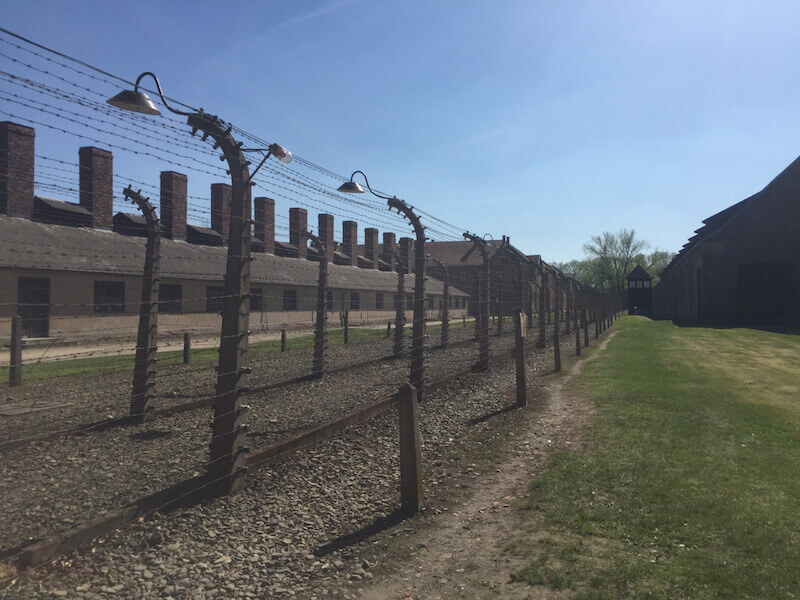
Some writers suggest you don’t need a guide at Auschwitz and that everything is well signposted. I beg to differ. I had a guide and it made all the difference – a lot of the backstory isn’t on the boards, and many of the guides are accompanied by historians who want nothing more than to share their knowledge with you. I suggest you take one of the excellent Auschwitz tours Krakow has to offer below:
Once you’ve explored the city’s World War II history, you might want to probe its post-war heritage. The best place to do that is by visiting one of the Krakow main attractions, Nowa Huta, a concrete suburb of planned Soviet architecture, which was designed to make this eastern suburb the ‘ideal socialist’ urban space. One highly popular way to visit the district is in an original East German Trabant. Wish I’d done that – those East German cars won’t be around forever. With the “first” Cold War crumbling (I suspect we’re headed towards the second), relics of Soviet rule are becoming rarer.
TIP: Make your way visit to Kraków easier by purchasing a city card and museum pass.
Best places to eat in Krakow
Your vacation adventures in Krakow must include some of the culinary variety.
Like music, there’s something else you can’t get away from in Krakow, and that is food. It is exquisite and inexpensive and varied (as I discovered on my Krakow food tour).
With so much choice, you may be tempted to throw your hands up in confusion and run into someplace familiar, like the Hard Rock Cafe. Nothing against these good folk, mind you, but please don’t.
Head out to sample some pierogis instead (calling them steamed dumplings doesn’t do them justice), eat in a Milk Bar (for stodgy but delicious specialties) and… CHOCOLATE. I have only one word for you: Wedel’s, on the main square. You can eat your chocolate or drink it, hot or cold, or get it gift-wrapped to take home. You’ll be hooked, and you’ll keep coming back. Ask my waistline.
On the streets, you’ll find bagels and pretzels for sale on every street corner, sold by street vendors in kiosks around the city. It seems all I did in Krakow was eat.
Speaking of which… ice cream. I don’t know what it is with Krakow but ice cream shops are as ubiquitous as foreign exchanges. Many shops have lines sneaking down the street. My favorite was the Ice Lab, something to do with nitrogen, but it seems to have closed. Keep an eye out in case it reopens at another location!
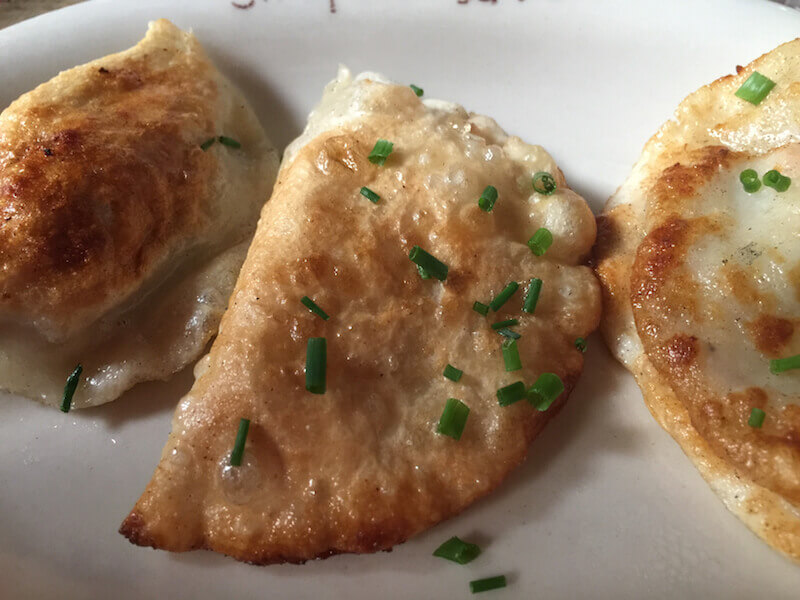


I don’t drink but… Polish vodka. There are shops that sell every conceivable flavor and strength and where you can sample anything ranging from pepper to chili to lemon vodka (yes, you can take a vodka tour).
In the sole instance of rudeness I witnessed during my entire week in Krakow, I was with a group in a vodka shop and asked for a glass of water. The saleslady looked at me in disgust. “This is a SHOP, not a restaurant,” she spat.
And then, of course, craft beer…
Here’s something else I wish I’d known about (one of the more unusual things to do in Krakow): the memorial to Elvis Presley.
What travel bloggers have to say about their favorite Kraków experiences
Nicole Labarge of Travelgal Nicole: “The highlight of Wieliczka salt mines, 300 metres below ground, is the magnificent and massive St. Kinga’s Chapel dating back to the 17th century, known for its fabulous acoustics and the Bible stories intricately carved on its walls by miners.”
Kamila Anna Napora of My Wanderlust: “You can get zapiekanka – a typical Polish warm sandwich made of half a baguette, mushrooms and melted cheese – at Okrąglak (Plac Nowy, Kazimierz) where day or night, the line is long but definitely worth the wait, especially at 3am after the crazy night out!”
Elisa Subirats of World In Paris: “Without leaving the tourist center it was easy to find some of the best restaurants in Krakow, or cafés frequented by locals and where it was easy to interact with them. One of my favorite places was Planty Park surrounding the heart of the city, the perfect place to get a glimpse of local life and people-watch.”
Faye Haines of Delve Into Europe: “The place I loved most in Krakow was the Wierzynek Restaurant in the main square – it’s been open since 1364, has eight opulent dining rooms and incredible food, including the best mushroom soup I’ve ever had.”
Stephanie Craig of History Fangirl: “While most people go to Wawel Cathedral, I wandered into the smaller Church of Saint Mary during a break from a conference and found that I had a super spiritual moment in the middle of a city that can feel overwhelmingly touristy.”
How safe is Krakow? Here’s what Allison Green of Sofia Adventures has to say: “As a solo female traveler, I fell in love with Kraków, especially Kazimierz, the old Jewish Quarter, where I felt incredibly safe day and night, with its great coffee shops and restaurants (and I loved stopping everywhere to photograph the gorgeous, creative street art).”
Is Krakow safe at night for solo women?
If you’re testing out Krakow solo travel, yes, by every measure. I would certainly steer clear of loud groups of drunken men late at night, but I’d do that anywhere. They are more of a nuisance than a danger and most times mean no harm.
I did, however, witness several instances of boorish behavior by tourists (mostly from the UK) who come here to celebrate a rite of passage – graduation, engagement, or wedding. I’m all for celebration, but one woman told me she had seen several men expose themselves and ‘measure and compare’ the bit they had exposed – right next to her table! Perhaps they were too drunk to notice they weren’t in someone’s bathroom. It’s a difficult call for Krakow’s authorities (who did not witness this particular incident): keep visitors coming to Krakow without letting a few rotten apples scare everyone else away. But sorry, no.
Best hotels in Krakow for your first visit
Finding the best place to stay in Krakow won’t be complicated and there are hotels in every range, including short-term apartments through such services as Airbnb Krakow or Homeaway (find my general take on Airbnb here).
Among the best Krakow hotels are the Old Town Krakow hotels, like the elegant and stylish Polski Pod Bialym Orlem, near the Florianka Gate, and the boutique Indigo Krakow, part of the Intercontinental chain (without any of that chain hotel feel at all).
Where to stay in Krakow in the mid-range? You can try something different and utterly modern and stay in Kazimierz, the Jewish quarter, at the stylish Puro. Or you might prefer an apartment if you like your own facilities, like the Novum Apartamenty near the market square.
Krakow is not an expensive city and budget hotels are plentiful (as for hostels Krakow is full of them – just beware of the noise in some if you’re not a party animal!)
It’s not difficult to find the best place to stay in Krakow for your travel style. Click here to compare and check out prices and availability of the many hotels in Krakow.
Krakow visitors guide and travel resources
Krakow is easy to get to and get around in. Here are a few additional facts that might help your trip.
- The city of Krakow is well-served by rail and air (I flew straight into Krakow, which you can do directly from most European cities). If you’re coming from overseas and land in Warsaw, you can fly or take the rapid train from Warsaw to Krakow (about three hours). City breaks to Krakow are easy from across Europe.
- My best discovery was Walkative, a free Krakow walking tour company (actually, it’s national). The tour is free, and you tip the guide whatever you want. It will usually be less than you’d pay for a regular organized tour, and the guides at Walkative were A-mazing! (They also have some paid tours but I was happy to stick to the free ones.) Not sure what to see in Krakow? I took a street art tour and a World War II history tour. Both were excellent and you’ll discover Krakow differently.
- Beware your currency in Krakow: exchange rates can vary by a euro or more from one to the next. I was warned against exchanging on the main square, yet I found reasonable rates there, as I did in the Jewish quarter. The worst I found was at Florianska 3, in the passageway.
- Now, for Krakow food. I’ve already mentioned the divine iced chocolate at Wedel’s on the main square (so good I have to mention it again). For the best pierogi in Krakow, try Pierogarnia Krakowiacy on ul. Szewska 23, just off the main square. They have all the traditional versions, plus some unusual ones like tomato mozzarella or duck with apple. For breakfast, I headed each morning to Fitagain Cafe on ul Szczepanska 7. Enormous breakfasts, excellent coffee, and a Pavlova to die for.
- The best time to visit Krakow is the shoulder season. I was there in April, the weather was sunny, cool in the evening, and short-sleeved weather during the day. Ideal for checking out all the best places to visit in Krakow Poland! I suspect September and October would be similar. Summer can be very hot and crowded though. Spending Christmas in Krakow? Winter isn’t a great idea if you have sensitive lungs because many homes still burn coal for heating in winter and pollution can be bad. But – everyone raves about Christmas markets in Krakow. Yuletide vacations in Krakow sound rather magical. So maybe a winter visit after all…
And please – don’t forget your travel insurance before you go! Two outstanding insurers are for travelers are Visitors’ Coverage and SafetyWing – whoever you choose, make sure you get insurance for any trip abroad.



